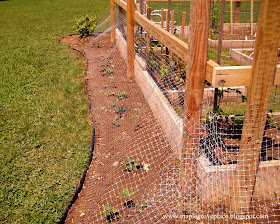How Does My Garden Grow? - Part 5
Transplanting Seedlings and Planting Seeds Outdoors
Months of planning, building, preparing, and dreaming, and FINALLY the time had come to plant my Kitchen Garden! The raised beds we built and filled with organic materials had composted nicely over the winter months. You can read about how we built our "compost sandwiches" in an earlier post. The seedlings that I started indoors had matured, and the danger of frost was behind us. It is time to plant!!
I am really excited about how wonderful the seedlings look. I planted the seeds indoors in the middle of March and have been nurturing them ever since, making sure they have the right amount of water and light and air. The seedlings need to have a period of adjustment in going from the indoor environment to the outdoors. Ten days before I wanted to plant, I started moving the seedlings outdoors for increasingly longer periods of time so they would get used to the atmosphere and the temperatures. This process is called "hardening off," and their movement in the gentle breezes strengthens the stems of the plants. The first day I set them out on a shaded porch for about an hour. I lengthened the time by an hour each day. The first time I left them out overnight, I felt like I had kicked "the babies" out of the nest.
On planting day, I waited until late in the afternoon/early evening when the soil was warm but the sun was not as hot. The transplants would have several hours overnight for their roots to adjust to the soil. If you plant them in the heat of the day, they could wilt and stress out. I am using the vertical and square foot gardening methods in my garden. I measured and marked off the beds by 12 inch squares. I tapped some galvanized roofing nails into the bed frames and stretched mason's string from one side to the other. (You don't actually have to set the strings. You can "eyeball" it or use a yardstick, but I did this to demonstrate visualy the square foot concept.)
I dug holes in the soil for the transplants. A hand trowel or a bulb dibble are useful garden tools for this purpose. The organic peat pots that I planted my seeds in can be planted directly into the soil and will break down. I chose to tear the corners, however, to give the plant roots easier access to the soil. This composted soil is dark and rich and crumbly. I noticed lots of earthworms as I was digging the holes. They are a gardener's friends because they burrow through the soil, allowing water and air to enter it, which the roots need to develop and grow. Also, the worms' castings add rich nutrients to the soil.
I save coffee grinds, egg shells, and vegetable trimmings to add to my compost pile. When I was planting, I placed some crushed egg shells into the holes to add calcium near the plants roots. Crushed egg shells sprinkled on the soil surface around the plants also deters slugs because they resist crawling through the sharp-edged bits. Coffee grinds are acidic and are particularly loved by shrubs like roses, azaleas and rhododendrons. I also sprinkled some sparingly in the garden beds around the beans, cucumbers, and squashes. They help to ward off slugs and snails.
It was a good feeling to get these transplants into the garden. I had planted the seeds and watched them grow into healthy plants. I'm anxious to watch them continue to grow and bear "fruit."
I decided to plant some strawberry plants around the outside perimeter of the garden. It seemed like very usable space to grow berries, and it will making grass cutting around the garden fence a little easier. The only problem is that the Chickie-Babes will love to dig in the dirt, and those young, tender-rooted strawberry plants just wouldn't survive their digging. Plus, once the berries ripen, it will be a race against the chickens for the harvest. Our solution? We covered the strawberry plants with some 36" plastic fencing that resembles chicken wire (but is less expensive). We used nylon ties to fasten it to the garden fence and landscape pins to stake it to the ground. We secured 2"x4" wire to the fence rails to a height of 5'. I think our garden is pretty secure against those clawing, digging plow-like feet.
Thanks for following along on my garden journey. I'll be sure to post an update as the garden grows and flourishes. I have no doubt that it will! Soon I'll be posting an inside and outside tour of the new Potting Shed. The finishing decorative touches are underway!















